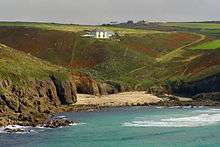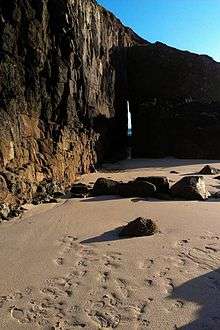Nanjizal
Coordinates: 50°03′14″N 5°41′35″W / 50.054°N 5.693°W

Nanjizal (or Mill Bay) is a beach and cove in the civil parish of Sennen, Cornwall, England, United Kingdom. Situated one mile to the south-east of Land's End, Nanjizal has no direct access via road and is usually reached via the South West Coast Path from Land's End in the north, or from Porthgwarra to the south. Nanjizal is also a noted bird watching location[1]
Geography
Nanjizal is a cove and valley facing west into the Atlantic Ocean It is bounded on the north side by the headland of Carn Boel and Trevilley Cliff and to the south is the headland of Carn Lés Boel and Higher Bosistow Cliff.[1] Depending on tides and storms the beach can vary from sand to boulders. On the south is the 'Song of the Sea' (Zawn Pyg), an arch where the sea has worn through a tall narrow passageway. Inside the cove are large rockpools with many types of sea anemones and seaweeds. To the north is a distinctive rock close to the cliff known as the 'Diamond Horse'. There are also a number of other caves further round the beach.

History
The City of Cardiff was a collier in water ballast heading for her home port of Cardiff. She left Le Havre on 6 March 1912 and rounded the Lizard at midnight on 20 March in a freshening southerly gale. By dawn she was trying to round Land's End but was beaten back as far as Porthcurno. She passed close to Tol-pedn at 0900 and there were fears for her safety as the gale increased and veered WSW. By 1100, unable to make headway she anchored a mile south of Land's End and less than half a mile from Carn Lés Boel, the southern flank of Nanjizel. Her engines were kept on full ahead but she was slowly drifting towards the shore and with a sudden squall she struck rocks 150 yards out. She was brought ashore on a flooding tide. The crew, two wives and a two-year-old were carried to land on the rocket apparatus by the Sennen Life-saving Apparatus Team who had followed the ship along the shore. The skeleton can be seen at low tide.[2]
Wildlife and ecology
Nanjizel is within the Porthgwarra to Pordenack Point Site of Special Scientific Interest (SSSI), designated in 1977 for its granite cliffs and maritime heath.[3][4] The valley is a constant effort site (CES) for the West Cornwall Ringing Group which monitors the birds in the valley. Breeding birds include common chiffchaff (Phylloscopus collybita), common whitethroat (Sylvia communis), dunnock (Prunella modularis), Eurasian blackcap (Sylvia atricapilla), Eurasian wren (Troglodytes troglodytes) and sedge warbler (Acrocephalus schoenobaenus). Other birds found include brambling (Fringilla montifringilla), cirl bunting (Emberiza cirlus), common grasshopper warbler (Locustella naevia), Eurasian siskin (Spinus spinus) lesser redpoll (Acanthis cabaret) and subalpine warbler (Sylvia cantillans).[5] Rareties ringed in the autumn of 2014 were aquatic warbler (Acrocephalus paludicola), barred warbler (Sylvia nisoria) and paddyfield warbler (Acrocephalus agricola).[5] A first for Britain occurred on 8 October 2008 with the trapping, and the measuring of biometric data, of an alder flycatcher (Empidonax alnorum).[6] A first for Cornwall occurred on 2 September 2015, when a Blyth's reed warbler (Acrocephalus dumetorum) was ringed. There have been six Isles of Scilly records and one from Devon so it was considered long overdue for Cornwall.[7][8]
In popular culture
The Doctor Who episode "The Smugglers" was filmed here on 19 Jun 1966; in it "The TARDIS" materialises on a beach.[9]
Gallery
 View north across Nanjizal cove from Higher Bosistow Cliff
View north across Nanjizal cove from Higher Bosistow Cliff- Nanjizal beach at sunset, looking out to sea
- Nanjizal beach at sunset, looking south
- View through the Zawn Pyg rock arch
 Mill Bay, or Nanjizal, June 2005
Mill Bay, or Nanjizal, June 2005
References
- 1 2 Explorer Map 102 Land's End (B2 ed.). Southampton: Ordnance Survey. 2010. ISBN 978 0 319 24116 5.
- ↑ Larn, Richard; Carter, Clive (1969). Cornish Shipwrecks The South Coast. London: Pan Books. ISBN 0 330 23474 9.
- ↑ "Porthgwarra to Pordenack Point". Magic Map Application. Retrieved 6 August 2015.
- ↑ "Porthgwarra to Pordenack Point" (PDF). Natural England. Retrieved 16 December 2014.
- 1 2 Grantham, Mark. "Ringing at Nanjizal, Cornwall's other CES". West Cornwall Ringing Group. Retrieved 6 August 2015.
- ↑ Wilson, Kester. "Alder Flycatcher in Cornwall: new to Britain". British Birds. British Birds Rarities Committee. Retrieved 25 November 2015.
- ↑ Grantham, Mark. "Blyth's Reed Warbler at Nanjizal - a first for Cornwall". West Cornwall Ringing Group. Retrieved 11 September 2015.
- ↑ "Blyth's Reed Warbler (Acrocephalus dumetorum)". BirdGuides. Retrieved 11 September 2015.
- ↑ Francis, Colin. "Nanjizal Bay". Doctor Who locations guide. Retrieved 6 August 2015.
External links
| Wikimedia Commons has media related to Nanjizal Beach. |